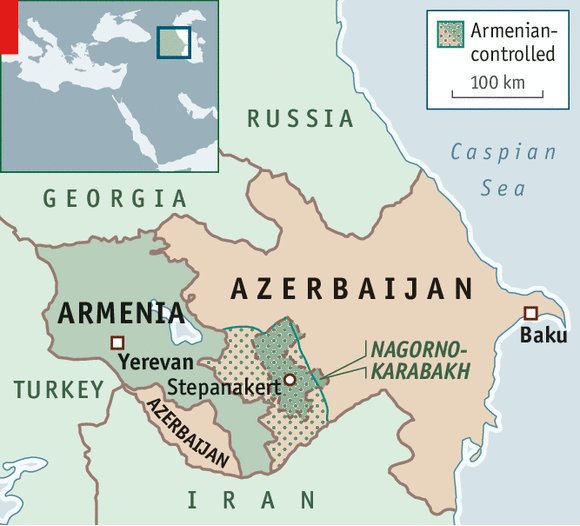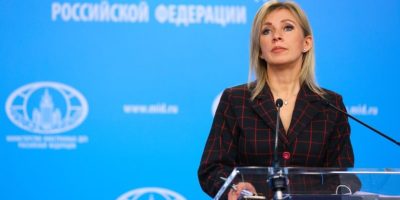Nagorno-Karabakh; No More a Frozen Conflict
“Thus, the Nagorno-Karabakh issue is not a territorial argument between Armenia and Azerbaijan. It was raised not by Armenia but by the people of Nagorno-Karabakh”
The history of the conflict
Wars and tragedies recognize neither borders nor nationalities. The Caucasus region with its multiethnic identity, rich mineral resources and important geostrategic position has always been an arena of clash of interests between colonial powers. The Armenian-Tatar (later called Azeri) conflict goes back to 1905-1907, where the Russian empire in order to shift the peasant uprising in the Caucasus inflamed an ethnic hatred between the two people leading to first Armenian-Tatar clashes. With the dissolution of the Russian empire in 1917, borders were redrawn in the region between different ethnicities. These borders were not redrawn by peaceful means. Wars broke up between the three main Caucasian nations; Armenians, Azerbaijanis and Georgians. One of the bloodiest battles was fought on Nagorno Karabakh region.
In 1921, Russians were back to the Caucasus, this time under the Red flag. By 1921, according to Soviet statistics, Armenians constituted 95% (130,000) of the population of Nagorno-Karabakh and only 5% (6,500) Tatars (Azeris). But Soviets didn’t take into consideration the demography, instead the Central Committee of Communist Party annexed Nagorno-Karabakh to Azerbaijan “taking into consideration the importance of ethnic peace between the Muslims and Armenian and the economic ties between NK and Azerbaijan”.
Starting 1988, Armenians in Nagorno-Karabakh demanded reunification with Armenia. For the first time in Soviet history a mass national movement began challenging the Soviet system. The decision of Nagorno-Karabakh Regional Council to unite with Armenia outraged Azerbaijani authorities. In February 21, 1988 the Karabakh parliament voted in favor of unification with Armenia (110 in favor and 30 rejected) later in 1992 NK declared its independence from Azerbaijan. This move triggered a war that lasted until a Russia-brokered ceasefire was signed in 1994.
From frozen to erupted conflict
Former President Heidar Aliev, the father of the current Azerbaijani President Ilham Aliev had spent the last few years of his life negotiating with his Armenian counterpart to find a peaceful solution based on recognizing the self-determination of Karabakh Armenians, in return for the Azerbaijani provinces captured by the Armenian forces. But his son, whom in 2012, was declared as the most corrupt leader in the world, ignored his father’s diplomacy and repeated that in case Armenians do not surrender Karabakh, then Azerbaijan would use military force. Aliev also went further by claiming that Armenia itself was part ancient Azerbaijan.
During the last 10 years where there was a boom in the oil prices, Azerbaijan increased its military budget and modernized its army. Something which has pushed President Aliev to think that he can solve the Nagorno-Karabakh conflict through military means. Yet, oil production started prematurely decreasing few years ago. Worst, the international oil prices collapsed in 2014, falling from $110 a barrel in mid-2014 to just $33 in early April. The state income, heavily dependent on oil exports, was cut four to five times. With the devaluation of Azerbaijani currency protests broke out in Baku, Azerbaijani capital and lead to social unrest. Many observers expected a military escalation to divert the public attention from the domestic problems. For some military analysts the latest Azerbaijani Blitzkrieg proved something else: Ilham Aliev intended to bring significant change by occupying land under Karabakh control to boost his legitimacy already shaken by the collapse of his extractive economy.
On the April 1, Azerbaijan launched a full scale war lasted till April 6. Following five days of clashes that led to fatal casualties on both sides, a Russian sponsored ceasefire was implemented. Aliev who was hoping to capture some territories failed to do so, while the Armenian side in Nagorno Karabakh defended its land but with heavy cost. Moreover, Human Rights organizations worldwide were alarmed to see Azerbaijani soldiers have beheaded an Armenian-Yezidi soldier and massacred a civilian family in Talish village.
As the Russian-brokered truce entered into force, U.S., Russian and French diplomats co-chairing the OSCE (Organization for Security and Cooperation in Europe ) Minsk Group had traveled to Baku and Yerevan to calm the situation. Analysts may argue that the current truce will not longer and soon may explode due to lack of interests from regional and international actors and the continues militarization of both sides of the conflict.
Regional and international interests
There is a risk that Karabakh may turn into an arena where regional and international actors can turn it into a proxy war. Russia is a direct actor in the conflict. Putin is playing “carrot and stick” with Armenia and Azerbaijan. Even though, Russia is Armenia’s political and military ally, (the former maintains a military base in Armenia), but Moscow is also providing heavy arms to Azerbaijan. Under the pretext to “keep the balance in the region” and prevent other countries to supply heavy weapons to the warring sides, as Russian PM Dmitry Medvedev stated. This issue has sparked renewed and stronger criticism from Armenia following last week’s outbreak of heavy fighting in Nagorno-Karabakh. The Armenian official circles even pushed Armenian President Serje Sarkissian to publicly criticize Russia’s arms sale to Azerbaijan. With this action, Russia is doing its best to distance Azerbaijan from Turkey and the West and keep it under her sphere of influence. Often this is happening on the expense of Armenia, where Russia is treating Armenia as a colony not a sovereign state. But the latest anti-Moscow protests in Yerevan made Putin’s administration to think twice, if they wanted to avoid another colorful revolution then they must support their only ally in the region.
U.S. is worried that Moscow may now argue that if the ceasefire is collapsed then Russia may propose a deployment of Russian peacekeepers. Both European Union and US want to weaken Russia’s influence in Southern Caucasus. The memory of Georgian war in 2008 is still fresh; therefore, they can’t confront Russia in the region. EU’s primary concern is the gas; that is, to secure Azerbaijan’s gas reaching its continent by bypassing Russia. EU wants to decrease its dependency on Russian gas. In 2002, together with Turkey and Azerbaijan they had initiated the plan to build Nabucco pipeline, but this was unsuccessful too, the project faced both economic and political challenges and eventually aborted. First, Turkey was not able to secure the flow of gas due to PKK attacks. Second, EU started to fund the building of the pipeline without securing the source of the gas.
Iran is also concerned in this conflict for many reasons. Many political analysts were surprised from Iran’s position regarding the crisis, and raised the question; “How could Iran (a majority Shia country) support (Christian) Armenia against the (Shia) Azerbaijan?” Iran’s strategic depth in this conflict is beyond religion. Northern Iran is mainly populated by Azeris. In the beginning of 1990s, Azerbaijani leaders didn’t hide their true intentions about their unity attempts with “Iranian Azerbaijan” and the plan to establish a “Greater Azerbaijan”. This plan brought Armenia and Iran closer. Furthermore, Iran is also worried of Israeli infiltration in Azerbaijan, where the former is providing heavy weapons and training the Azeri army. Here, the Israeli interest should not be ignored; recently the right wing Israeli newspapers launched a campaign in support of Azerbaijan. While, Avigdor Lieberman, the former Israeli Foreign minister, where his party is accused of taking Azerbaijani financial support, has justified the Azeri aggression.
Turkey, who considers itself the guardian of Turkish speaking states, its PM claimed “Turkey would support Azerbaijan to the end”. Turkey instead of condemning Azerbaijani aggression encouraged Ilham Aliev to continue the war and capture territories. Many political analysts were worried that Armenia, in order internationalize the conflict may engage in skirmishes with the Azeri forces in Nakhichevan exclave bordering with Turkey. This action would have forced Turkey to interfere and thus would give a green light for Russian military intervention. This scenario was discussed in Armenian media. Finally, let us not forget that the Commander-in-Chief of the United Armed Forces of the CIS (Commonwealth of Independent States), in 1993, Marshal Shaposhnikov, during the Karabakh war, warned that the intervention of a third party (Turkey) in the conflict would lead to the outbreak of the Third World War.Is there a diplomatic solution?
Can diplomacy solve the problem? Actually, diplomacy is the only means to reach to a compromise solution but only if Nagorno-Karabakh is part in the negotiation process.
The OSCE from 1994 onwards has given its backing to a mediation process as part of the “Minsk Group” led by Russia, United States and France as co-chairmen.
Many formulas were rejected by both Armenian and Azerbaijani sides. Armenia supports the principle of self-determination as the only solution for Nagorno-Karabakh. That is the current citizens of the region decide if they will remain independent or unite with Armenia. While Azerbaijan rejects this proposal. It defends its territorial integrity and suggests giving a special administrative autonomy for Nagorno-Karabakh but within its borders. Something rejected both by Armenia and Nagorno-Karabakh.
For the Armenians the Karabakh war was an issue of national liberation, they were forced to be part of it, and there was no other choice. They had to either leave their homes or flee or to fight. They were either going to kill or be killed. It is important to know that it was Nagorno-Karabakh who imposed its will on Armenia and not the other way. Thus, the NK issue is not a territorial argument between Armenia and Azerbaijan. It was raised not by Armenia but by the people of NK. Hence, it should be looked at only as an issue of the self-determination of nation. The only feasible solution should be a compromise by both sides. It’s clear that the status quo is in favor of Armenia; already NK outside Azerbaijani control and its army has captured Azeri territories. Thus, Azerbaijan is in no position to put conditions. The latest “failed invasion” proved that a quick victory on Karabakh is impossible. Therefore, negotiations must start based on the idea “Give me security, take your land”. First, the self-determination of Nagorno-Karabakh must be respected. Whether, its people want a unity with Armenia or total independence. Second, a safe corridor must be guaranteed between Armenia and NK. Third, Armenia withdraws its troops from the captured territories outside NK administrative areas. Heavy weapons must be withdrawn from both sides of the zones, and peacekeeping forces (composed of neutral states) should be sent to monitor this process. Forth, refugees from both sides must be returned to these areas, if not then compensated by the rival governments. Finally, it should be the role of NGOs and civil societies to build dialogue, trust and bridges between the two nations and produce a new generation far from hatred and enmity.
Yeghia Tashjian has graduated from Haigazian University in political science. He is a Lebanese-Armenian political activist, researcher and blogger. He has founded the New Eastern Politics forum/blog in 2010. Currently, he is the regional officer of Women in War gender based think tank. He is also contributor to many local and regional newspapers and blogs.
















